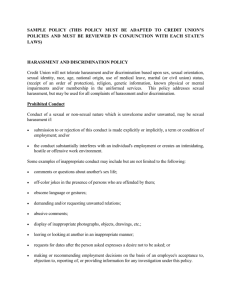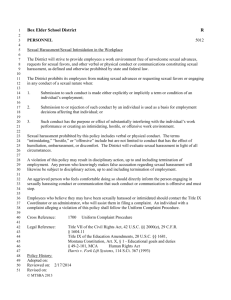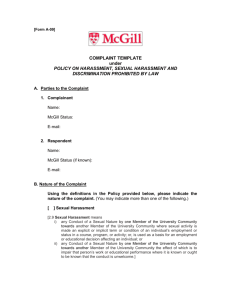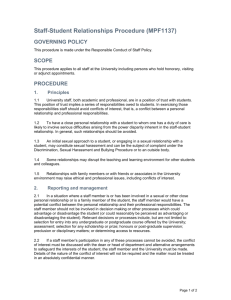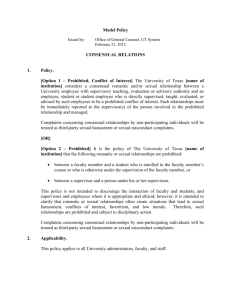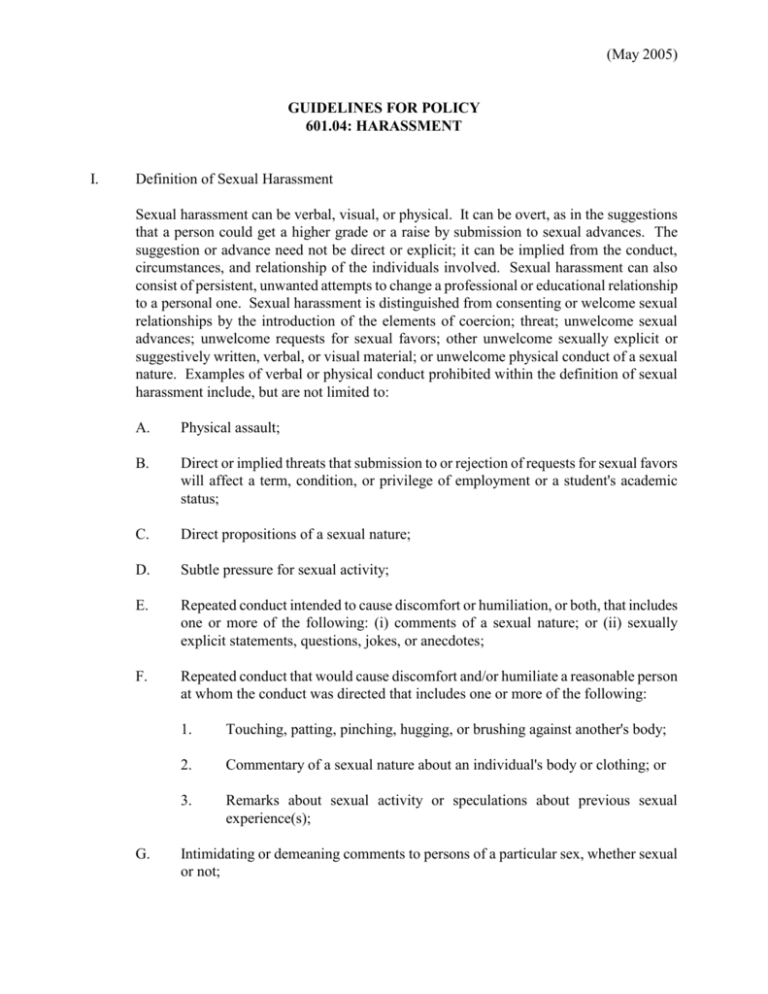
(May 2005)
GUIDELINES FOR POLICY
601.04: HARASSMENT
I.
Definition of Sexual Harassment
Sexual harassment can be verbal, visual, or physical. It can be overt, as in the suggestions
that a person could get a higher grade or a raise by submission to sexual advances. The
suggestion or advance need not be direct or explicit; it can be implied from the conduct,
circumstances, and relationship of the individuals involved. Sexual harassment can also
consist of persistent, unwanted attempts to change a professional or educational relationship
to a personal one. Sexual harassment is distinguished from consenting or welcome sexual
relationships by the introduction of the elements of coercion; threat; unwelcome sexual
advances; unwelcome requests for sexual favors; other unwelcome sexually explicit or
suggestively written, verbal, or visual material; or unwelcome physical conduct of a sexual
nature. Examples of verbal or physical conduct prohibited within the definition of sexual
harassment include, but are not limited to:
A.
Physical assault;
B.
Direct or implied threats that submission to or rejection of requests for sexual favors
will affect a term, condition, or privilege of employment or a student's academic
status;
C.
Direct propositions of a sexual nature;
D.
Subtle pressure for sexual activity;
E.
Repeated conduct intended to cause discomfort or humiliation, or both, that includes
one or more of the following: (i) comments of a sexual nature; or (ii) sexually
explicit statements, questions, jokes, or anecdotes;
F.
Repeated conduct that would cause discomfort and/or humiliate a reasonable person
at whom the conduct was directed that includes one or more of the following:
G.
1.
Touching, patting, pinching, hugging, or brushing against another's body;
2.
Commentary of a sexual nature about an individual's body or clothing; or
3.
Remarks about sexual activity or speculations about previous sexual
experience(s);
Intimidating or demeaning comments to persons of a particular sex, whether sexual
or not;
(May 2005)
H.
II.
Displaying objects or pictures which are sexual in nature that would create a hostile
or offensive employment or educational environment, and serve no educational
purpose related to the subject matter being addressed.
Complaint Resolution
A.
B.
Procedures for Reporting Complaints
1.
Any member of the institution community who believes that he or she has
been the victim of sexual harassment, as defined in Section I, may bring the
matter to the attention of any academic or administrative officer, Dean,
Associate Dean, Director, supervisor, or advisor. When a complaint has been
reported to any of these individuals, the recipient of the complaint will
forward the complaint to the appropriate institution official, who shall be
designated by the President to coordinate the investigation of such
complaints. The President and the Vice Chancellor for Legal and Human
Resources of the Department of Postsecondary Education shall be promptly
notified of the complaint. The Vice Chancellor for Legal and Human
Resources must be kept informed regarding the progress and results of the
investigation of the complaint.
2.
The complainant should present the complaint as promptly as possible after
the alleged sexual harassment occurs. The complainant should submit a
written statement of the allegations. Retaliation against a student or employee
for bringing a sexual harassment complaint is prohibited. Retaliation is itself
a violation of this policy and may be grounds for disciplinary action.
3.
It is the intention of this policy to resolve complaints of sexual harassment as
quickly as possible. Except in extraordinary cases, all complaints will be
investigated and resolved within forty-five (45) days of receipt. Every
possible effort shall be made to ensure confidentiality of information received
as part of the investigation. Complaints will be handled on a "need to know"
basis with a view toward protecting the interests of both parties.
4.
The investigation record shall consist of formal and informal statements from
the alleged victim, the alleged offender, witnesses, and others deemed by the
investigator to have pertinent knowledge of the facts involved in the
complaint. The investigation will afford the accused a full opportunity to
respond to the allegations. If the results of the investigation and informal
resolution of the complaint are accepted by the alleged victim and he or she
desires no further action against the alleged harasser, the complainant will
sign a statement requesting that no further action be taken.
Formal Action
1.
If the complaint cannot be resolved on an informal basis, the complainant
(May 2005)
may file a formal complaint. Each complainant has the right to proceed with
or withdraw from the formal complaint procedure once it has been submitted.
The issues involved in the complaint should not be changed once the charge
has been made. However, administrative procedures may be revised to
accommodate issues arising during the investigation which were not known
to the complainant or the institution when the initial complaint was filed.
C.
2.
The appropriate institution official will notify the accused in writing of the
decision to take formal action. Formal action will consist of the Title IX
procedures set forth in State Board of Education Policy Number 620.01 for
complaints against institution employees.
3.
Complaints against students will be handled according to usual and
customary student discipline procedures in effect at the institution.
4.
It is the intent of the policy to provide for a prompt and thorough
investigation of any complaints. The time limits set forth within these
guidelines are subject to change as needed to ensure a satisfactory conclusion
to the investigation.
Appeal
The accused or the complainant may, by written request, appeal the decision to the
Chancellor within fifteen (15) calendar days of notification of a decision. The
Chancellor shall use the appeal process for Title IX complaints set forth in State
Board of Education Policy Number 620.01.
D.
Remedial Action
Based on the findings of the hearing panel and the decision of the President of the
institution and the Chancellor, disciplinary action will be imposed as appropriate
depending on the severity of the findings.
III.
Education
A sexual harassment educational program may consist of seminars, workshops, videos,
and/or printed materials. The educational elements of this policy seek to achieve the
following goals through dissemination of this policy and providing a training program by: (1)
ensuring that all administrators, faculty, students, and all employees are made aware of their
rights concerning sexual harassment; (2) notifying individuals of conduct that is prohibited;
(3) informing administrators and supervisors about the proper procedures in addressing
complaints.


